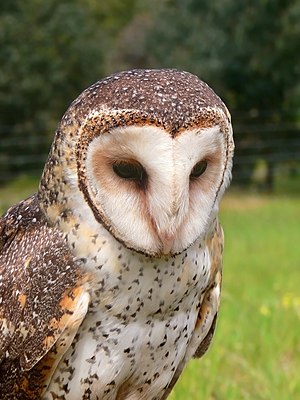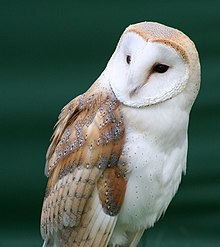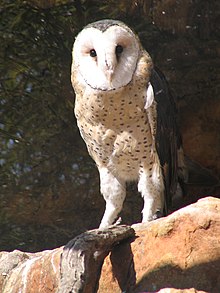Barn owls (genus)
| Barn owls | ||||||||
|---|---|---|---|---|---|---|---|---|

|
||||||||
| Systematics | ||||||||
|
||||||||
| Scientific name | ||||||||
| Tyto | ||||||||
| Billberg , 1828 |
The barn owls ( Tyto ) are a species-rich genus within the barn owl family. The genus is distributed almost worldwide.
features
Barn owls are characterized by their eye-catching heart-shaped face veils . This distinguishes them, among other things, from the mask owls , in which the face veil is more V-shaped. Barn owls are long-legged owls with relatively long wings and a relatively short tail. It is characteristic of the entire family that the backward-facing inner toe is just as long as the middle toe.
The plumage is very different. Individual barn owl species have a very light upper side of the body. Among the brightest are the barn owl subspecies Tyto alba ernesti , which occurs in the Mediterranean region, and the Australian barn owl . One of the darkest species is the sooty owl , which is native to New Guinea and southeastern Australia. The largest species is the Tasmanian barn owl . It reaches a body length of 47 to 55 centimeters and weighs between 600 and 1,200 grams.
distribution
The genus occurs on all continents except in Antarctica . The greatest diversity of species is found in Australia , New Guinea, and Indonesia . In contrast, the genus is completely absent in central , northern and most of East Asia .
The barn owl, which also occurs in Central Europe, is one of the species with a very large distribution area . Their distribution area extends over Europe, South Asia and Africa. The distribution area of the American barn owl , which is seen in older literature as a subspecies of the barn owl, extends over South and North America.
Numerous barn owls have an extremely small range. This applies, for example, to the Curacao , Hispaniola and Lesser Antilles Barn Owl . These species, which are limited to a few, small islands, are particularly threatened by habitat destruction. Little is known about the specific way of life of these endemic species. As they have long been considered a subspecies of the barn owl, little effort has been made to investigate their specific food spectrum, their sound repertoire or their reproductive biology.
species
The family system is in a state of radical change. Many subspecies are assigned to individual species, such as the barn owl that occurs in Central Europe. On the basis of DNA studies, some authors have now assigned various subspecies a species status. The number of species varies accordingly depending on the author. The assignment of species to the genus of masked owls or the genus of barn owls is also controversial. Thus, near the African is Lake Tanganyika occurring Kongomaskeneule assigned to the bay owl by some authors. Here the division of the International Ornithological Congress was followed.
The genus includes:
- Black Owl ( T. tenebricosa )
- Spotted soot owl ( T. multipunctata )
- Minahassa Barn Owl ( T. inexpectata )
- Taliabu Barn Owl ( T. nigrobrunnea )
- Tanimbar Barn Owl ( T. sororcula )
- Manus Barn Owl ( T. manusi )
- Gold Owl ( T. aurantia )
- New Holland owl ( T. novaehollandiae )
- Sulawesi barn owl ( T. rosenbergii )
- Malegasse Owl ( T. soumagnei )
- Barn Owl ( T. alba )
- America barn owl ( T. furcata )
- Sunda Barn Owl ( T. javanica )
- Andaman barn owl ( T. deroepstorffi )
- Eastern grass owl ( T. longimembris )
- African grass owl ( T. capensis )
- Hispaniola Barn Owl ( T. glaucops )
Some independent species listed by König and Weick are considered subspecies by the IOC, including the Curacao barn owl ( Tyto furcata bargei ), the Lesser Antilles barn owl ( Tyto furcata insularis ), the Galápagos barn owl ( Tyto furcata punctatissima ), the Cape Verde Barn Owl ( Tyto alba detorta ), São Tomé Barn Owl ( Tyto alba thomensis ), the Australian Barn Owl ( Tyto javanica delicatula ) that Boang Barn Owl ( Tyto javensis crassirostris ), the Seram Masked Owl ( Tyto sororcula Almae ) and Tasmania Barn Owl ( Tyto novaehollandiae castanops ).
The following species are known to be fossil or sub-fossil:
- Bahamas owl ( T. pollens ), subfossil from Andros Island , Bahamas
- Barbuda barn owl ( T. neddi ) †
- Tyto melitensis
supporting documents
Single receipts
- ↑ a b König et al., P. 209
- ↑ König et al., P. 225
- ^ IOC World Bird List 9.1
literature
- Claus König , Friedhelm Weick: Owls of the World . Christopher Helm, London 2008, ISBN 978-0-7136-6548-2

